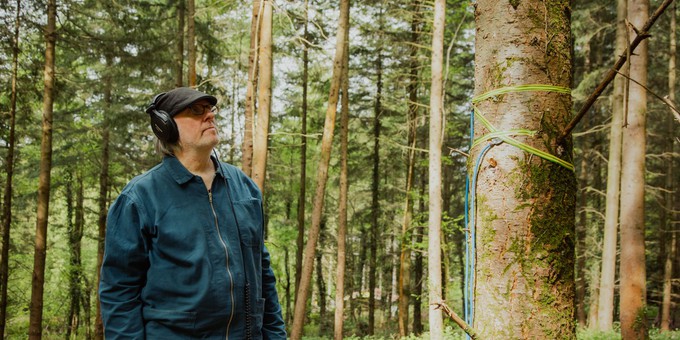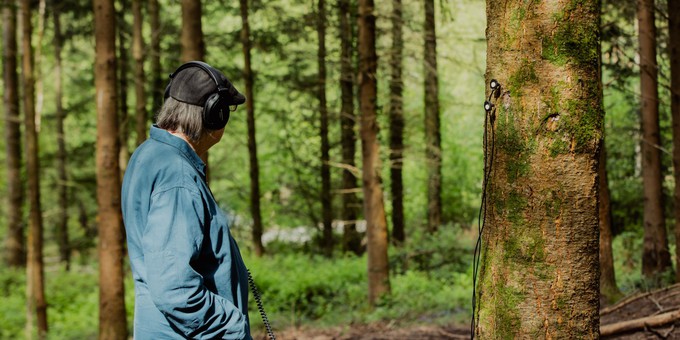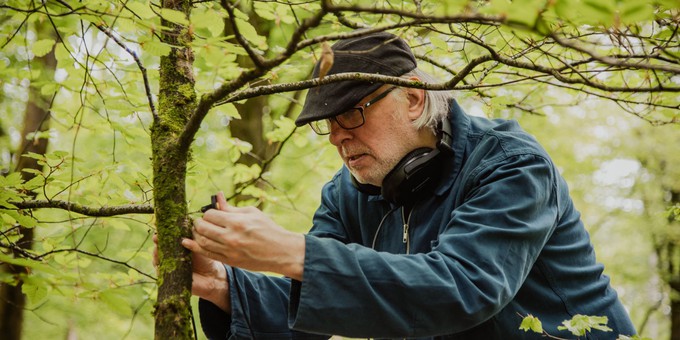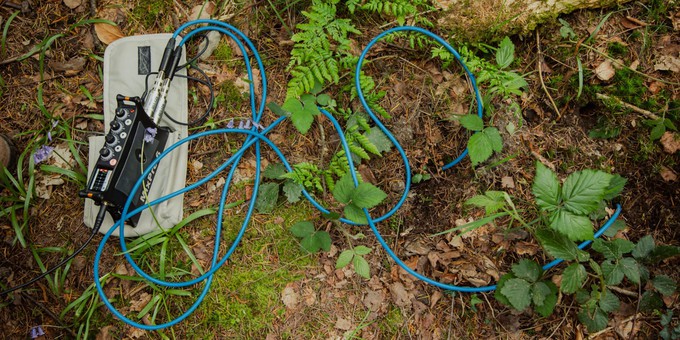
This month we invite audiences to step into the Forest of Dean and explore the inner world of the trees in a new audio-visual experience, The Secret Sounds of Trees.
Last month we caught up with sound artist Jez riley French to learn about his creative process, find out about some of the sounds he has recorded for this installation and how he is working with composer Lau Nau on this soundscape.
This is part 2 of the interview. You can read the first part of the interview here.
How has listening to the forest affected you? Can you describe your experience of listening to the forest?
Listening, if you give it time, can be transformative to ones sense of place, and across the scale; from being immersed in a single sound source, to perceiving more and more of all the sounds around us at any given time, and of course, to aspects that signify less positive change.
At Beechenhurst, and in other forests over the past four or five years, I’ve noticed a quite radical drop in insect activity for example. Of course there is also the now constant sound of flight paths and traffic nearby.
I know such sounds frustrate some listeners, but it is what is there and if, like me, you reject the divide that the word ‘nature’ implies, separating the human species from all others, then those sounds are ‘nature’ sounds also, it’s just that they are made by one species without consideration of any other.
I find thinking about such sounds in that way gives one a sharper sense of our impact. That said, listening to species sounds below the surface, without those human sounds is a remarkable experience, and that is what The Secret Sounds of Trees will allow the audience to do.

How would you like audiences to approach this experience? And what do you hope audiences will take away from this experience?
To get the most from this, or any listening experience, the key really is to give time and space to the listening. That sounds obvious, simple, but as a species we’re generally not that good at listening.
We tend to try to occupy the space we are in, physically and sonically, even if we think we’re being quiet. So find a comfortable position in the area of the forest the event will be taking place in and realise that being there means you are part of the piece also.
The willingness to let all the other sounds have priority for a while will, hopefully, give each person a more meaningful experience, shared with everyone else there and of course, the forest itself. It’s important to remember also that we are encroaching on all the other species, and accepting that can help with the listening, with finding space to listen.
Any tips for audiences on how to listen deeply during the installation?
It does tend to be different for each person, but I think with events such as this, where we’re not on our own, the key is to be aware of your individual role in the collective quietness that will enhance the experience. Allow time for the sounds to take us beyond our usual, short attention spans.
Deep, or active listening, at its core is really about allowing the place or situation to guide the process. You have to give up control in a way. At least give up the idea that you know what a forest sounds like in this instance.
For this specific location we are providing straw bales to help the experience. Not many of use can stay totally still whilst standing for more than a few minutes.

How does being at Beechenhurst make you feel?
I tend to think, as I’ve already alluded to, that how we feel about a specific place takes time, and it should take time. I hadn’t visited this part of the forest before this project so I’m still processing my impressions, but, given that I was there specifically to listen, it did take me a couple of days to find my feet so to speak.
I think that’s one of the positive things about accessible spaces like Beechenhurst; you can go for a few hours or a day, but you can also keep returning and the closer you look, and listen, the more there is. Personally, if I keep returning to a place I have to allow it to influence my reason for doing so. Not to return with expectations, but with an understanding that I, we, have to do something more than use environments for our pleasure.
I spent some time around the borders of Beechenhurt also, thinking about the tension there is for any artist working in such places. We bring ourselves, our equipment and, hopefully, more people to them at times, but with work such as The Secret Sounds of Trees there is an important element of allowing audiences in to the sensory world of other species that isn’t normally accessible, so there is the artistic value but also a wider purpose that links to environmental knowledge and respect.

The Secret Sounds of Trees is a new audio-visual installation taking place at Beechenhurst in the Forest of Dean from Friday 22 - Sunday 24 September. To find out more and to book tickets, visit the event page here.
